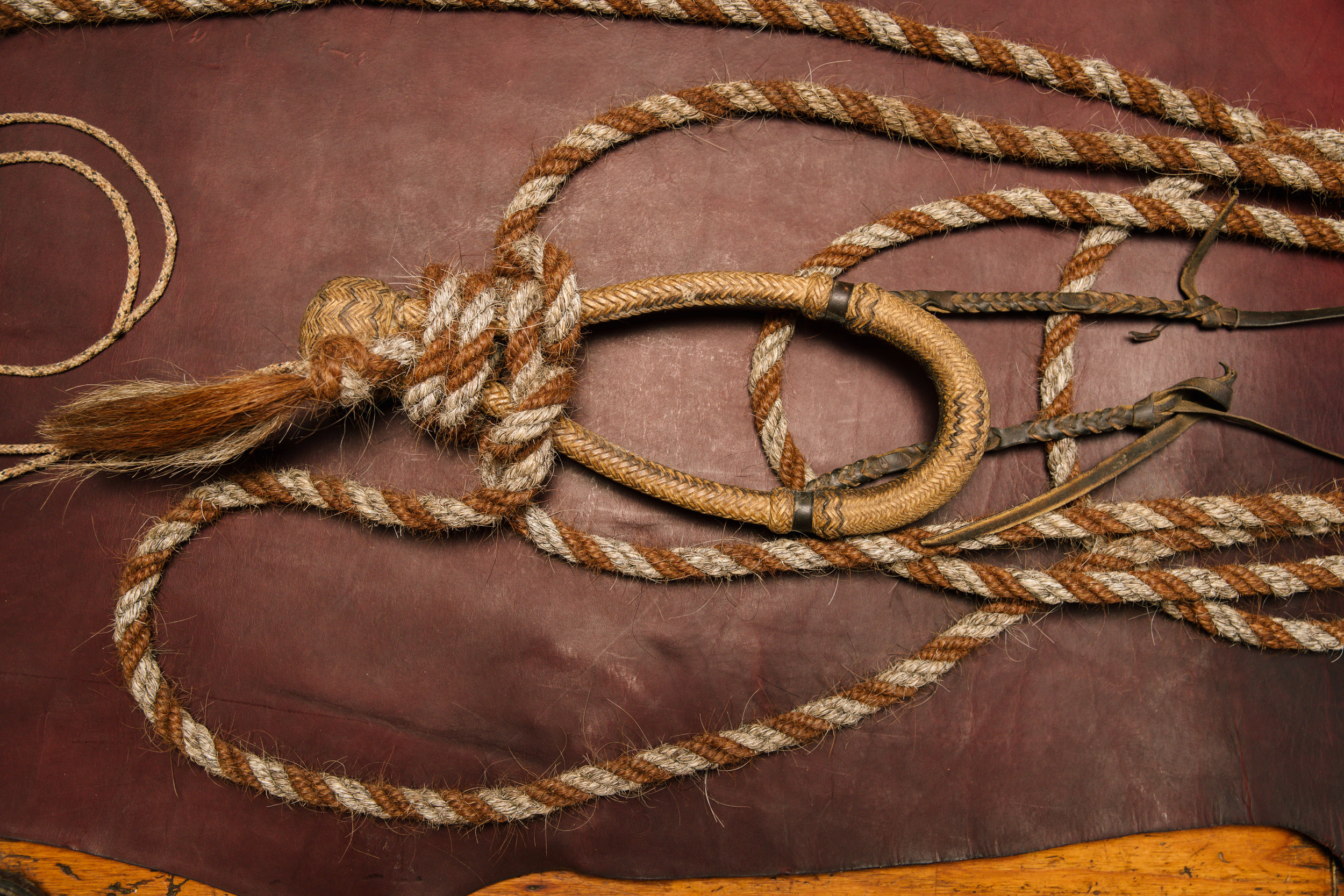At Home on the Range

Steve Harris has earned a widespread reputation among horse people near and far for the skill with which he is keeping alive the ancient tradition of rawhide braiding.
Story by Dick Baltus, Photos by Thomas Boyd and Miguel Cortes
He could be from another time, and it’s not because he still operates a flip phone.
Steve Harris stands in a corner of his small shop surrounded by the tools of his trade and the products of his labors in various stages of evolution. The first saddle he ever made sits in a corner, up and out of the way. Another one in progress straddles a stand near a workbench filled with antique tools.
Thin strands of rawhide hang from poles suspended from the ceiling, waiting to be meticulously braided around the cores that form the foundation for Harris’ much-sought-after hackamores (at its simplest, a bridle without a bit).
Books and notebooks grace shelves affixed to one wall. Most bear titles related to Harris’ profession, but on the top shelf a collection of Louis L’Amour paperbacks stands out from the others.
Harris wouldn’t look out of place gracing the cover of one of these classic Westerns. All he’d need do is add a Stetson and maybe a pair of chaps to the wardrobe he sports now – Clemons boots, Wranglers, a flannel shirt buttoned all the way to the top and a neat haircut mussed just enough to hint that a hat did indeed recently occupy the perch.
It’s a fitting look for a “Trenzador,” a man who has earned a reputation as widespread as an open plain for his skills in the ancient skill/art of rawhide braiding.
You could pass Harris’ shop at the western edge of Roseburg hundreds of times – and if you frequent the Melrose area, you have – and never notice it. It could be any well-used, slightly off-kilter outbuilding on any small farm.
But people certainly notice what comes out of it.
Harris has sold his saddles and hackamores to customers from here to the East Coast and beyond. They pay up to $600 for the privilege of sliding one of Harris’ creations over the nose and ears of their horse. Harris’ saddles start at $6,000.
He sells to serious horsepeople who are as patient as they are discerning. Harris’ full hackamores typically come with a 13-month wait time. Saddles can take 20 months.
Cindy Sloan, of Joseph, Ore., paid $500 and waited several months for her bosal, the noseband piece of a hackamore.
“You can go out and buy a bosal for $100 or $150, but I thought I’d try one of Steve’s,” Sloan says. “I love it. It’s really a piece of art, but functional art.”
Watching Harris work, it’s impossible not to notice his artistry and attention to detail, as well as the ease with which he employs both while waxing eloquently on any number of subjects – from the task at hand to the history of Vaquero horsemanship (a tradition developed in Mexico and Spanish California that produced the riding and roping skills of the North American cowboy).
He speaks like a professor teaching a class at Cowboy University. Now Harris is adding the finishing touches to a heel knot, a rawhide ball that helps the hackamore drop from a horse’s face to create space, which a skilled rider uses to send signals to his or her horse.
What did this piece start out as? he’s asked. “It started out as a kangaroo hopping down a dry gulch in Neil Harvey’s back lot in Australia,” he answers.
Harris’ hands move around the tightly wound knot, prying open with one tool the narrow strips wrapped in a herringbone pattern, then threading through the space a lighter colored strip with the equivalent of heavy sewing needle.
And what’s the appeal of braiding?
“It’s a thing with depth in a disposable world.”
He repeats the process around the ball until he reaches the starting point of his “up-and-down arrowhead” design, then tightens and forms the knot into its final perfectly round shape. Then he finishes off the bosal by applying a coat of Leather Sheen with a small artist’s brush.
Where do his creations go after they leave?
“They go ride under skies I’ll never see, on horses I’ll never touch, and that’s an honor.”
The finished bosal looks as much like a decorative wall hanging as it does a utilitarian tool for a horse person. An argument could be made that it looks too nice to use. And, indeed, Harris says, some of his creations never leave their owners’ living rooms.
But no matter how pretty his creations, they are first built to work. “I use hackamores all the time myself,” he says. “That is to say, I go rope heavy cattle on steep slopes with nothing but a hackamore on the horse’s head. I expect these to be used.”
Horses have been part of Harris’ life as long as he can remember. “My grandpa put me on a horse when I was a kid, and I never recovered,” he says.
His father was an agriculture teacher at Roseburg High School and his students, including his son, were required to complete a project before leaving his class. Harris’ project was braiding, a technique that can be traced back as far as the ancient Phoenicians that involves using strips of untreated cowhide to fashion elaborate and beautiful plats and knots.
In 1996, after deciding to pursue braiding as a profession, Harris traveled around Oregon picking the brains of every braider he could find. He then completed a saddle apprenticeship in Idaho before returning home to set up shop.
"MY GRANDFATHER PUT ME ON A HORSE WHEN I WAS A KID, AND I NEVER RECOVERED." -Steve Harris
The more Harris braided, the better he got, the farther his reputation spread and the more work came his way. Most of his business today comes from word of mouth or from people who follow a horse trainer who uses his gear.
“But I have a fair number of people who are very serious about horsemanship, who did some research and decided it was worth waiting a year and paying a substantial amount of money to get a hackamore from my shop,” he says. “That is very flattering.”
Michael Marks, who lives in and is a native of Germany, recently ordered his third Harris bosal. He is one of many who understand that good things come to those who wait.
“I was in no hurry,” says Marks. “This is an investment expected to last at least for the rest of your life. When it comes to training a horse there is a saying: ‘It takes as long as it takes.’ Why shouldn’t this apply to the equipment?”
Harris says he is fortunate to have built a customer base that knows quality takes time. There aren’t many skilled braiders out there, but he is encouraged by “a renaissance of better horsemanship” that is driving increased demand for better gear.
He’s got all the business he can manage for now but, he says, “I can name 10 guys younger than me who are braiding, and that’s a good sign.”
Harris isn’t sure what braiding will look like years down the trail, but he might be getting a glimpse of it every night when he tucks his daughters into bed.
“My 3-year-old was stamping leather yesterday and my 5-year-old was begging to come to the shop. So they are interested,” he says.
If they keep watching their father, they will learn that working to keep the past alive can lead to a bright future.








